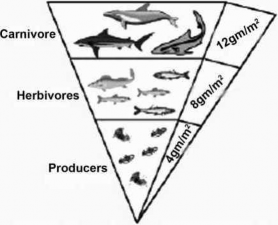2.4.2. Pyramid of Biomass
In order to overcome the shortcomings of pyramid of numbers, the pyramid of biomass is used. In this approach individuals in each trophic level are weighed instead of being counted. This gives us a pyramid of biomass, i.e., the total dry weight of all organisms at each trophic level at a particular time.
Pyramid of biomass is usually determined by collecting all organisms occupying each trophic level separately and measuring their dry weight. This overcomes the size difference problem because all kinds of organisms at a trophic level are weighed. Biomass is measured in g/m2.
(a) Upward pyramid

Upright Pyramid of Biomass
For most ecosystems on land, the pyramid of biomass has a large base of primary producers with a smaller trophic level perched on top.
The biomass of producers (autotrophs) is at the maximum. The biomass of next trophic level i.e primary consumers is less than the producers. The biomass of next higher trophic level i.e secondary consumers is less than the primary consumers. The top, high trophic level has very less amount of biomass.
(b) Inverted pyramid
In contrast, in many aquatic ecosystems, the pyramid of biomass may assume an inverted form.

Inverted Pyramid in an Aquatic Ecosystem
This is because the producers are tiny phytoplanktons that grow and reproduce rapidly. Here, the pyramid of biomass has a small base, with the consumer biomass at any instant actually exceeding the producer biomass and the pyramid assumes inverted shape.
